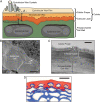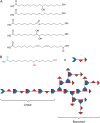The formation and function of plant cuticles
- PMID: 23893170
- PMCID: PMC3762664
- DOI: 10.1104/pp.113.222737
The formation and function of plant cuticles
Abstract
The plant cuticle is an extracellular hydrophobic layer that covers the aerial epidermis of all land plants, providing protection against desiccation and external environmental stresses. The past decade has seen considerable progress in assembling models for the biosynthesis of its two major components, the polymer cutin and cuticular waxes. Most recently, two breakthroughs in the long-sought molecular bases of alkane formation and polyester synthesis have allowed construction of nearly complete biosynthetic pathways for both waxes and cutin. Concurrently, a complex regulatory network controlling the synthesis of the cuticle is emerging. It has also become clear that the physiological role of the cuticle extends well beyond its primary function as a transpiration barrier, playing important roles in processes ranging from development to interaction with microbes. Here, we review recent progress in the biochemistry and molecular biology of cuticle synthesis and function and highlight some of the major questions that will drive future research in this field.
Figures




References
-
- Aroca R, Porcel R, Ruiz-Lozano JM. (2012) Regulation of root water uptake under abiotic stress conditions. J Exp Bot 63: 43–57 - PubMed
-
- Barthlott W, Neinhuis C. (1997) Purity of the sacred lotus, or escape from contamination in biological surfaces. Planta 202: 1–8
Publication types
MeSH terms
Substances
LinkOut - more resources
Full Text Sources
Other Literature Sources
Miscellaneous

